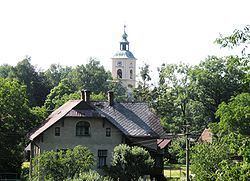Postal code 738 01, 739 54 Elevation 410 m Population 1,290 (2014) | First mentioned 1455 Website www.komorni-lhotka.cz Area 19.89 km² Local time Friday 3:13 AM | |
 | ||
Weather 1°C, Wind S at 14 km/h, 85% Humidity | ||
Komorn lhotka jubileum 90 let 23 10 2015
Komorní Lhotka (Polish: Ligotka Kameralna , German: Kameral Ellgoth) is a village in Frýdek-Místek District, Moravian-Silesian Region, Czech Republic. It has a population of 1,097 (2001 census), 21.5% of the population are the Poles. It lies in the historical region of Cieszyn Silesia.
Contents
- Komorn lhotka jubileum 90 let 23 10 2015
- Map of 739 53 KomornC3AD Lhotka Czechia
- Sborovky vojkovice komorn lhotka a byst ice nad ol 19 12 2015
- Etymology
- History
- References
Map of 739 53 Komorn%C3%AD Lhotka, Czechia
Sborovky vojkovice komorn lhotka a byst ice nad ol 19 12 2015
Etymology
Lhotka and Ligotka are diminutive forms of Lhota in Czech and Ligota in Polish respectively, which are common names for villages in both Czech Republic and Western Poland. The word refers to the medieval custom of village founders being exempt from paying duties to their lords for a period of 5–8 years. As it is a common name it is often accompanied by an distinguishing adjective. Komorní Lhotka was first mentioned as Buczkowa Lhota, where Buczkowa was an adjective derived from personal name Buczek (in contrary to what might seem from beech trees, Czech and Polish: buk). Later the adjective was replaced or dropped and eventually in the 19th century it became known as Komorní (Polish: Kameralna and German Cammeral) as it was belonging to Teschener Kammer.
History
The village was first mentioned in 1455 as Buczkowa Lhota. Politically the village belonged initially to the Duchy of Teschen, formed in 1290 in the process of feudal fragmentation of Poland and was ruled by a local branch of Piast dynasty. In 1327 the duchy became a fee of the Kingdom of Bohemia, which after 1526 became part of the Habsburg Monarchy.
After the 1540s Reformation prevailed in the Duchy of Teschen and many local citizens became Lutherans. After issuing the Patent of Toleration in 1781 they subsequently organized a local Lutheran parish as one of over ten in the region.
After Revolutions of 1848 in the Austrian Empire a modern municipal division was introduced in the re-established Austrian Silesia. The village as a municipality was subscribed to the political and legal district of Cieszyn. According to the censuses conducted in 1880, 1890, 1900 and 1910 the population of the municipality dropped from 1,164 in 1880 to 1,038 in 1910 with a majority being native Polish-speakers (99.2%-100%) accompanied by a small German-speaking minority (at most 12 or 1.3% in 1880) and occasionally 1 Czech-speaking person. In terms of religion in 1910 the majority were Protestants (88.2%), followed by Roman Catholics (11.2%), Jews (3 people) and also 3 people adhering to another faiths. The village was also traditionally inhabited by Cieszyn Vlachs, speaking Cieszyn Silesian dialect.
After World War I, fall of Austria-Hungary, Polish–Czechoslovak War and the division of Cieszyn Silesia in 1920, it became a part of Czechoslovakia. Following the Munich Agreement, in October 1938 together with the Zaolzie region it was annexed by Poland, administratively adjoined to Cieszyn County of Silesian Voivodeship. It was then annexed by Nazi Germany at the beginning of World War II. After the war it was restored to Czechoslovakia.
